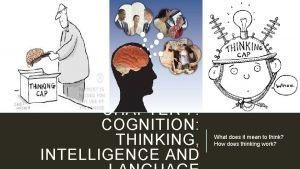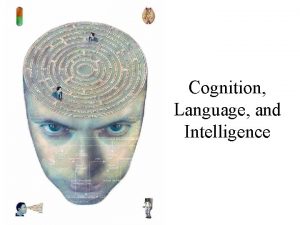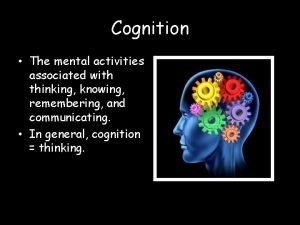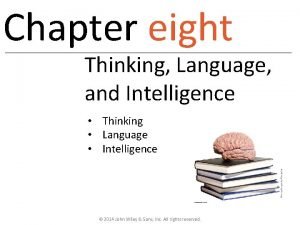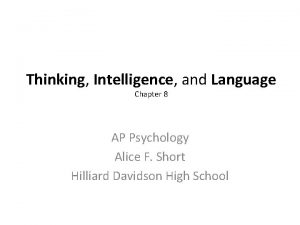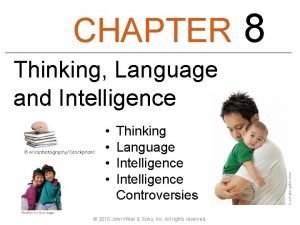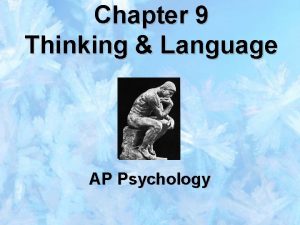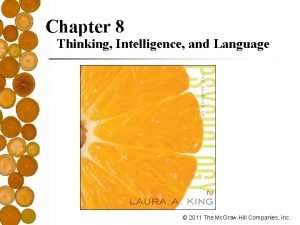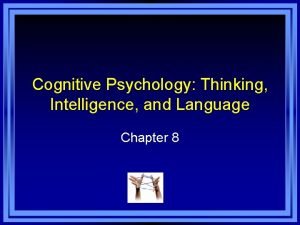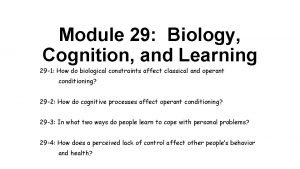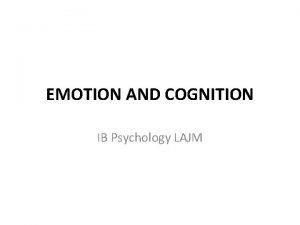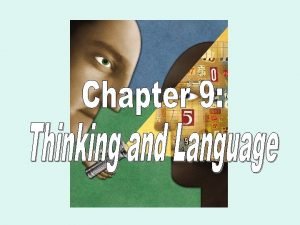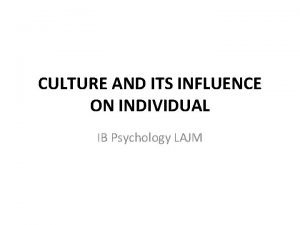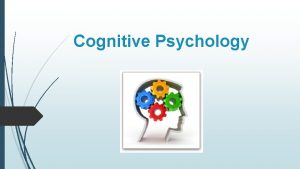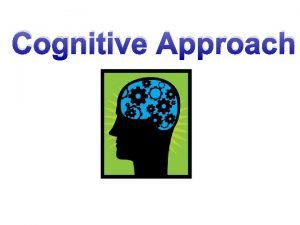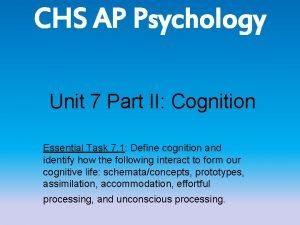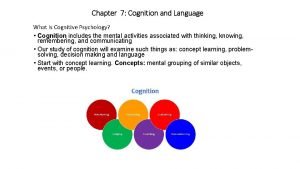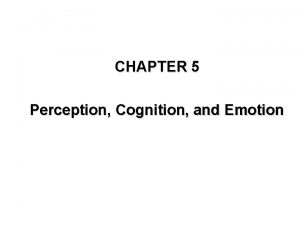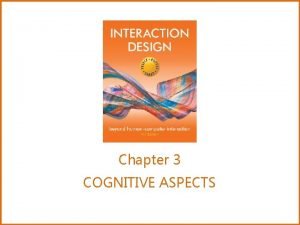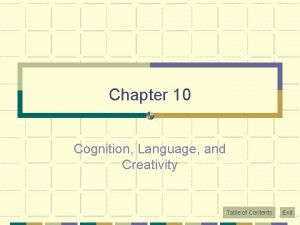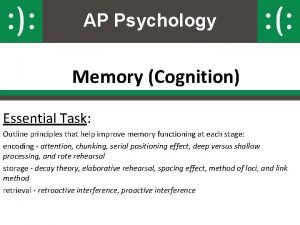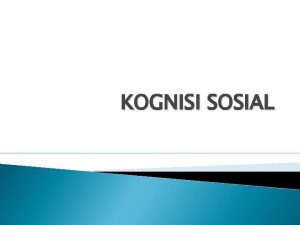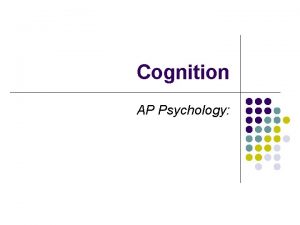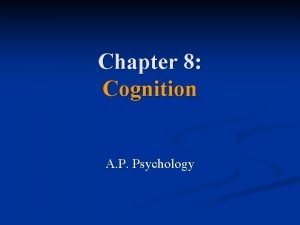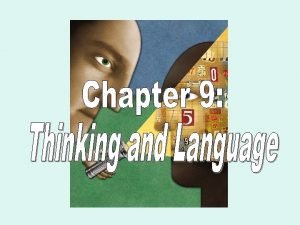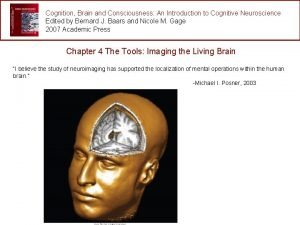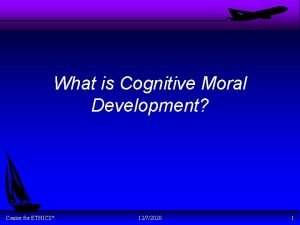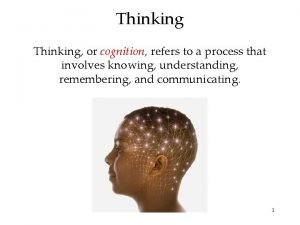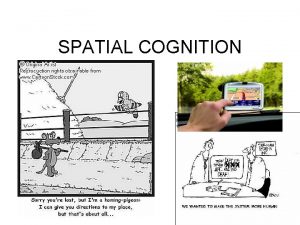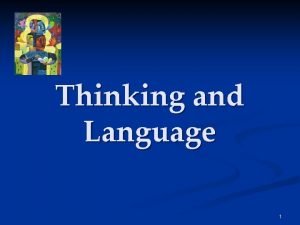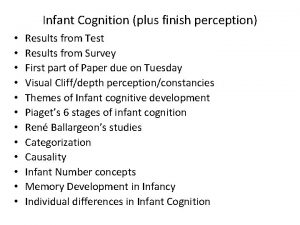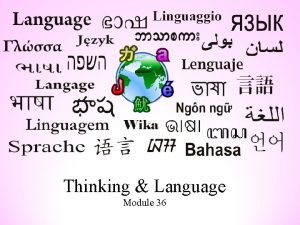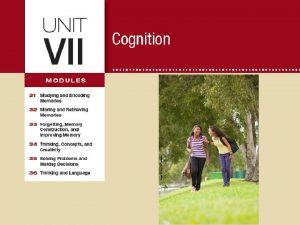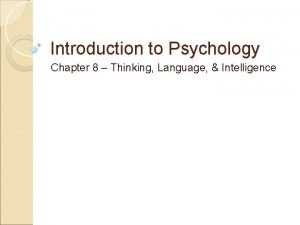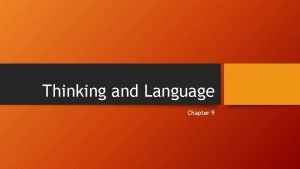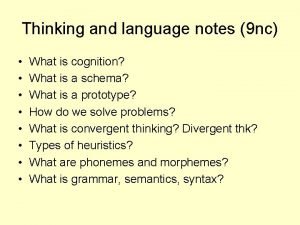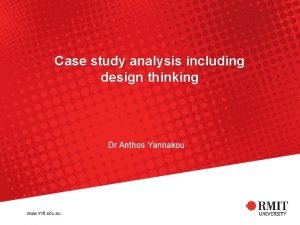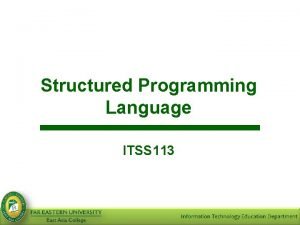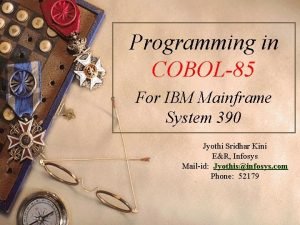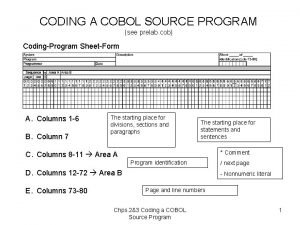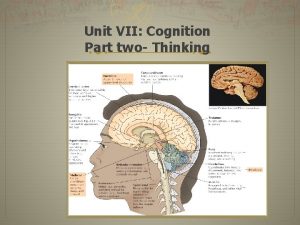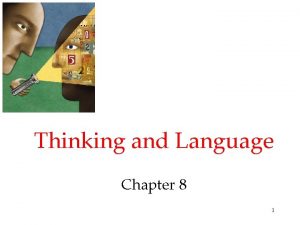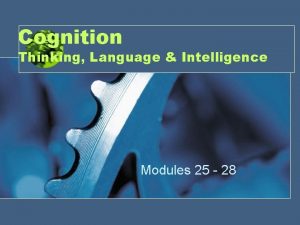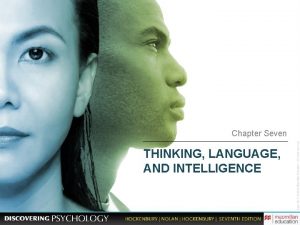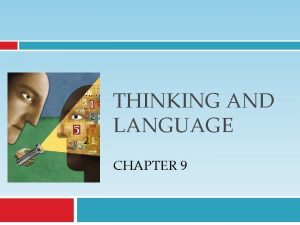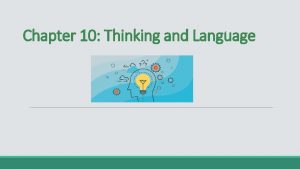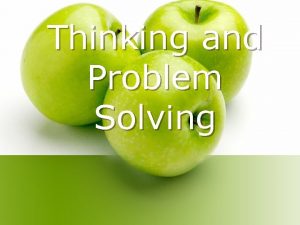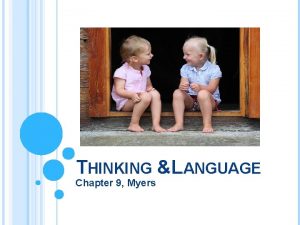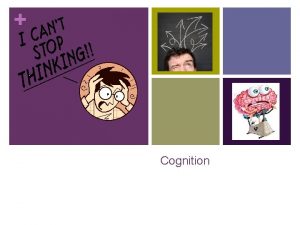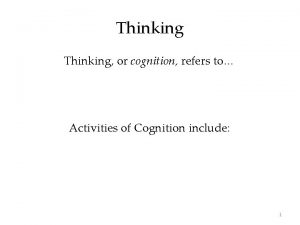Study Area 7 Cognition thinking intelligence and language






















































- Slides: 54

Study Area 7 Cognition: thinking, intelligence, and language

Thinking and Mental Images • Thinking (cognition): mental activity that goes on in the brain when a person is processing information – processing includes organizing, understanding, and communicating information to others • Mental images: mental representations that stand for objects or events and have a picture-like quality

Concepts • Concepts: ideas that represent a class or category of objects, events, or activities • Formal concepts: concepts that are defined by specific rules or features • Natural concepts: concepts people form as a result of their experiences in the real world – a platypus is a “fuzzy” natural concept (a mammal that lays eggs and has bird-like webbed feet)

Concepts • Prototype: a concept that closely matches Prototype: the defining characteristics of that concept • Prototype (standard definition): an original or first model of something from which other forms are copied or developed They tested the prototype of the car. He is developing a prototype for his invention. • prototypes develop according to the exposure a person has to objects in that category

Problem Solving • Problem solving: occurs when a goal must be reached by thinking and behaving in certain ways • Decision making: identifying, evaluating, and choosing between alternatives

Problem Solving • Trial and error (mechanical solution): problem-solving method in which one possible solution after another is tried until a successful one is found • Algorithms: very specific, step-by-step procedures for solving certain types of problems – will always result in a correct solution if one exists to be found § e. g. , mathematical formulas

Problem Solving • Heuristic: educated guess based on prior experiences that helps narrow down the possible solutions for a problem; also known as a “rule of thumb” rule of thumb – representative heuristic: assumption that any object (or person) sharing characteristics with the members of a particular category is also a member of that category

Problem Solving • Heuristics (cont’d) – availability heuristic: estimating the frequency or likelihood of an event based on how easy it is to recall relevant information from memory or how easy it is to think of related examples – working backward from the goal is a useful heuristic – break a goal down into subgoals, so that as each subgoal is achieved, the final solution is that much closer

Problem Solving • Insight: sudden perception of a solution to a problem – “aha!” moment – problem may be recognized as similar to another previously solved, for example

Problem-Solving Barriers • Functional fixedness: a block to problem solving that comes from thinking about objects only in terms of their typical functions • Mental set: the tendency for people to persist in using problem-solving patterns that have worked for them in the past

Problem-Solving Barriers • Confirmation bias: the tendency to search for evidence that fits one’s beliefs while ignoring any evidence that does not fit those beliefs

The String Problem How do you tie the two strings together if you cannot reach them both at the same time? Functional fixedness

(continued) Solution to the String Problem The solution to the string problem is to use the pliers as a pendulum to swing the second string closer to you. Functional fixedness

The Dot Problem Can you draw four straight lines so that they pass through all nine dots without lifting your pencil from the page and without touching any dot more than once?

(continued) Solution to the Dot Problem When people try to solve this problem, a mental set causes them to think of the dots as representing a box, and they try to draw the line while staying in the box. The only way to connect all nine dots without lifting the pencil from the paper is to draw the lines so they extend out of the box of dots— literally “thinking outside the box. ”

Creativity • To be creative is to pull existing knowledge into a new situation and quickly sort through potential outcomes. Of course: existing knowledge is something that anyone above a certain threshold on the IQ scale can amass. That intelligence number, it seems, is right around 100. • Being able to come up with creative ideas isn’t something you need an overly-high IQ to something you need an overly-high IQ accomplish. Once you’ve got a level of knowledge gathering and utilization that’s about average, you’re well on your way to having creative potential.

Creativity • Creativity, the process of solving problems by combining ideas or behavior in new ways requires a pattern of divergent thinking. – divergent thinking: a person starts from one point and comes up with many different ideas or possibilities based on that point (a kind of creativity – convergent thinking: a problem is seen as having only one answer, and all lines of thinking will eventually lead to (converge on) that single answer, using previous knowledge and logic


Intelligence • Intelligence: the ability to learn from one’s experiences, acquire knowledge, and use resources effectively in adapting to new situations or solving problems

Theories of Intelligence • Spearman’s two factor Theory – g factor: the ability to reason and solve problems; general intelligence – s factor: the ability to excel in certain areas; specific intelligence

Theories of Intelligence Gardner’s multiple intelligences Proposed by Howard Gardner in 1983, theory of multiple intelligences has revolutionized how we understand intelligence.

Theories of Intelligence Gardner’s multiple intelligences

Gardner’s Theory • According to Gardner, what kind of intelligence is being shown here? Movement / Kenesthetic

Gardner’s Theory • According to Gardner, what kind of intelligence is being shown here? Albert Einstein Logical/Mathematical

Gardner’s Theory • According to Gardner, what kind of intelligence is being shown here? Visual/Spatial

Gardner’s Theory • According to Gardner, what kind of intelligence is being shown here? Musical

Theories of Intelligence • Sternberg’s triarchic theory of intelligence: there are three kinds of intelligences 1. analytical, 2. creative 3. practical

Theories of Intelligence • Triarchic theory of intelligence (cont’d) – analytical intelligence: the ability to break problems down into component parts, or analysis, for problem solving – creative intelligence: the ability to deal with new and different concepts and to come up with new ways of solving problems – practical intelligence: the ability to use information to get along in life and become successful; “street smarts”

IQ Tests • Intelligence quotient (IQ): a number representing a measure of intelligence, resulting from the division of one’s mental age by one’s chronological age and then multiplying that quotient by 100 (ratio IQ) – allows testers to compare intelligence levels of people from different age groups Note: the deviation IQ replaced the ratio IQ

IQ Tests

IQ Tests • Wechsler Intelligence Tests yield a verbal score and a performance score, as well as an overall score of intelligence

IQ Tests

Development of IQ Tests • Reliability: the tendency of a test to produce the same scores again and again each time it is given to the same people • Validity: the degree to which a test actually measures what it’s supposed to measure

Development of IQ Tests • Standardization: the process of giving the test to a large group of people that represents the kind of people for whom the test is designed – norms: scores from the standardization group – most intelligence tests follow a normal curve • A normal distribution is a very important statistical data distribution pattern occurring in many natural phenomena, such as height, blood pressure, lengths of objects produced by machines, etc. Certain data, when graphed , creates a bell-shaped curve known as a normal curve, or normal distribution.

Normal distributions are symmetrical with a single central peak at the mean (average) of the data. The shape of the curve is described as bell-shaped with the graph falling off evenly on either side of the mean. Fifty percent of the distribution lies to the left of the mean and fifty percent lies to the right of the mean. The mean and the median are the same in a normal distribution.

The Normal Curve The percentages under each section of the normal curve represent the percentage of scores falling within that section for each standard deviation (SD) from the mean. Scores on intelligence tests are typically represented by the normal curve. The dotted vertical lines each represent one standard deviation from the mean, which is always set at 100. For example, an IQ of 115 on the Wechsler represents one standard deviation above the mean, and the area under the curve indicates that 34. 13 percent of the population falls between 100 and 115 on this test. Note: The figure shows the mean and standard deviation for the Stanford-Binet Fourth Edition (Stanford-Binet 4). The Stanford-Binet Fifth Edition was published in 2003 and now has a mean of 100 and a standard deviation of 15 for composite scores.

Development of IQ Tests • Deviation IQ scores: a measure of intelligence that assumes that IQ is normally distributed around a mean of 100 with a standard deviation of about 15 – IQ of 130 would be two standard deviations above the mean – IQ of 70 would be two standard deviations below the mean – the deviation IQ replaced the ratio IQ.

Development of IQ Tests • Cultural bias: & Cultural free tests - It is extremely difficult to develop a test that measures innate intelligence without introducing cultural bias. This has been virtually impossible to achieve. One attempt was to eliminate language and design tests with demonstrations and pictures. Another approach is to realize that culture-free tests are not possible and to design culture-fair tests instead. These tests draw on experiences found in many cultures.

Development of IQ Tests • Usefulness of IQ tests – IQ tests are generally valid for predicting academic success and job performance academic success

Intellectual Disability • Intellectual disability (intellectual developmental disorder): a person exhibits deficits in mental ability and adaptive behavior – IQ falls below 70 – adaptive behavior is severely deficient for a person of a particular chronological age – formerly known as mental retardation or developmentally delayed Terms are no longer politically correct!

Intellectual Disability • Intellectual disability can vary from mild to profound • Causes of developmental delay include deprived environments, as well as chromosome and genetic disorders, alcohol, dietary deficiencies and toxins in the environments

Giftedness • Gifted: the 2 percent of the population falling on the upper end of the normal curve and typically possessing an IQ of 130 or above • Does giftedness guarantee success?

Giftedness • Terman conducted a longitudinal study that demonstrated that gifted children grow up to be successful adults, for the most part. – Terman’s study has been criticized for a lack of objectivity, because he became too involved in the lives of his “Termites”, even to the point of interfering on their behalf.

Giftedness • Emotional intelligence: awareness of and ability to manage one’s own emotions, as well as the ability to be self-motivated, to feel what others feel, and to be socially skilled – viewed as a powerful influence on success in life

Heredity, Environment, and Intelligence • Stronger correlations are found between IQ scores as genetic relatedness increases • Heritability of IQ is estimated at 0. 50 • Flynn effect: IQ scores steadily increasing over time in modernized countries • The Bell Curve: a book that made widely criticized claims about the heritability of intelligence – stereotype threat is a situational predicament in which people are or feel themselves to be at risk of conforming to stereotypes about their social group.

Correlations Between IQ Scores of Persons With Various Relationships In the graph, the degree of genetic relatedness seems to determine the agreement (correlation) between IQ scores of the various comparisons. For example, identical twins, who share 100 percent of their genes, are more similar in IQ than fraternal twins, who share only about 50 percent of their genes, even when raised in the same environment.

Correlations Between IQ Scores of Persons With Various Relationships In the graph, identical twins are still more similar to each other in IQ than are other types of comparisons, but being raised in the same environment increases the similarity considerably.

Language • Language: a system for combining symbols (such as words) so that an unlimited number of meaningful statements can be made for the purpose of communicating with others

Elements and Structure of Language • Grammar: the system of rules governing the structure and use of a language • Syntax: the system of rules for combining words and phrases to form grammatically correct sentences • Phonemes: the basic units of sound in a language • Morphemes: the smallest units of meaning within a language

Elements and Structure of Language • Semantics: rules for determining the meaning of words and sentences • Pragmatics: aspects of language involving the practical ways of communicating with others, or the social niceties of language • Parse: (grammar) analyze syntactically by assigning a constituent structure to (a sentence)

Language and Cognition • Linguistic relativity hypothesis: theory that thought processes and concepts are controlled by language Wrong? • Cognitive universalism: theory that concepts are universal and influence the development of language

Animal Studies in Language • Studies have been somewhat successful in demonstrating that animals can develop a basic kind of language, including some abstract ideas. • Controversy exists over the lack of evidence that animals can learn syntax, which some feel means that animals are not truly learning and using language.

Ways to Improve Thinking • Mental activities that require creativity and the use of memory abilities can help keep the brain – – – Exercise regularly. … Train your memory. . Question facts. . Think positive. . Read!. . . Get enough sleep. . – Nourish your brain with a healthy diet. . – Eliminate Errors in Thinking.

The END - Study Area 7 Cognition: thinking, intelligence, and language
 Chapter 7 cognition thinking intelligence and language
Chapter 7 cognition thinking intelligence and language Chapter 7 quiz cognition thinking intelligence and language
Chapter 7 quiz cognition thinking intelligence and language Cognition language and intelligence
Cognition language and intelligence All the mental activities associated with thinking
All the mental activities associated with thinking The mental activities involved in acquiring storing
The mental activities involved in acquiring storing Is evaluating alternatives and making choices among them.
Is evaluating alternatives and making choices among them. When you group subcategories within broader concepts
When you group subcategories within broader concepts Ap psych thinking and language
Ap psych thinking and language Thinking affects our language, which then affects our:
Thinking affects our language, which then affects our: Evaluating alternatives and making choices among them
Evaluating alternatives and making choices among them Thinking intelligence and language
Thinking intelligence and language Module 29 biology cognition and learning
Module 29 biology cognition and learning Emotion and cognition ib psychology
Emotion and cognition ib psychology Cognition and personalization
Cognition and personalization Positive thinking vs negative thinking examples
Positive thinking vs negative thinking examples Thinking about your own thinking
Thinking about your own thinking Linear thinking vs holistic thinking
Linear thinking vs holistic thinking Perbedaan critical thinking dan creative thinking
Perbedaan critical thinking dan creative thinking Thinking about you thinking about me
Thinking about you thinking about me Cognition refers to
Cognition refers to Mental status examination
Mental status examination Sensorium in mse
Sensorium in mse Effect of culture on cognition ib psychology
Effect of culture on cognition ib psychology What is cognition
What is cognition Cognition definition
Cognition definition Mental set ap psychology
Mental set ap psychology What is cognition
What is cognition Types perception
Types perception Altered cognition in older adults is commonly attributed to
Altered cognition in older adults is commonly attributed to What is cognition
What is cognition Cognition definition
Cognition definition Priming psychology example
Priming psychology example Assimilation ap psychology
Assimilation ap psychology Jalan pintas mental
Jalan pintas mental Unlike b. f. skinner, noam chomsky believes that children
Unlike b. f. skinner, noam chomsky believes that children Availability heuristic ap psychology
Availability heuristic ap psychology Embodied cognition ap psychology
Embodied cognition ap psychology Cognition refers to
Cognition refers to Complex cognition
Complex cognition Moral cognition
Moral cognition Cognitive dissonance example
Cognitive dissonance example Spatial cognition examples
Spatial cognition examples Linguistic determinism
Linguistic determinism Cognition plus
Cognition plus Module 36 thinking and language
Module 36 thinking and language Eighteen month old becca is in the telegraphic speech phase
Eighteen month old becca is in the telegraphic speech phase Thinking chapter in psychology
Thinking chapter in psychology Chapter 9 thinking and language notes
Chapter 9 thinking and language notes Airline reservations typically decline after
Airline reservations typically decline after Starbucks design thinking case study
Starbucks design thinking case study Cobol area a and area b
Cobol area a and area b Ibm system/390
Ibm system/390 Wet curved surface area
Wet curved surface area Cobol area a and area b
Cobol area a and area b Whats lateral area
Whats lateral area

